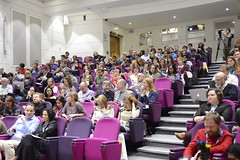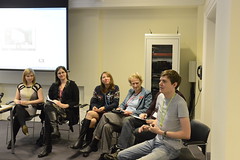SpotOn London
Posted by Eva Amsen, on 20 November 2012
 Last week I attended SpotOn London – a conference focused entirely on the role of the Internet on research, science outreach, science policy, tools, and related topics. There were talks about using alternative metrics to asses the value of research papers, discussions about doing outreach while working in the lab, issues related to women in science, workshops about new tools or tips on how to talk to politicians about science. The attendees were all interested in science, but not all of them were researchers. There were people working at tech companies, and writers, and even politicians. It was also a great opportunity to meet people in other fields, and be reminded that everything is different for physicists, for example.
Last week I attended SpotOn London – a conference focused entirely on the role of the Internet on research, science outreach, science policy, tools, and related topics. There were talks about using alternative metrics to asses the value of research papers, discussions about doing outreach while working in the lab, issues related to women in science, workshops about new tools or tips on how to talk to politicians about science. The attendees were all interested in science, but not all of them were researchers. There were people working at tech companies, and writers, and even politicians. It was also a great opportunity to meet people in other fields, and be reminded that everything is different for physicists, for example.
 Compared to scientific conferences, SpotOn is much more inclusive. The discussion sessions and workshops were all selected from submitted proposals, but it didn’t matter whether you were a student or a professor, or anyone else – any interesting proposals were assessed at face value. For example, the discussion session about juggling science communication and a research career was proposed and organized by two PhD students (Heather Doran and Jonathan Lawson) and included postdoc and PI panelists who all combine their research life with science communication activities. If you’re interested in this topic, you can watch the entire session here:
Compared to scientific conferences, SpotOn is much more inclusive. The discussion sessions and workshops were all selected from submitted proposals, but it didn’t matter whether you were a student or a professor, or anyone else – any interesting proposals were assessed at face value. For example, the discussion session about juggling science communication and a research career was proposed and organized by two PhD students (Heather Doran and Jonathan Lawson) and included postdoc and PI panelists who all combine their research life with science communication activities. If you’re interested in this topic, you can watch the entire session here:
Yes, all the talks and discussions were recorded. I also ran one of the discussion sessions, which is somewhat related to the one above. It was on “Stories behind the research” and the panel gave three different perspectives on the role of storytelling in science: Vibhuti Patel works for the Royal Society of Chemistry, a publisher and learned society; Ben Lillie runs The Story Collider, an event/podcast/magazine where people tell stories about science; Anne Osterrieder is half researcher, half science communicator. Between the three of them they covered issues related to finding out what makes a good story, when and where to share what, and why people – researchers as well as others – care about this.
In my intro to the discussion I also showed an example from the Node – this post by Tohru – to show how there can be interesting stories behind a paper that don’t make it into the paper itself, and how you can use blogs (such as the Node) to record those stories where relevant, and even link them to the paper in question. The discussion with the audience was really entertaining (with lots of laughs!), but also informative. There were professional science writers in the audience who said that they had a hard time getting scientists to share more than just the plain basics of the work, and researchers who were reluctant about connecting their work to the human experience of being a researcher. A full report from the “stories behind the research” session can be found on the SpotOn blog and the video is on their media page.
You can find links to all individual session pages (all with video!) here. My summary above is heavily focused on the science communication track and on talks aimed at researchers, because I think that’s what most of you are interested in, but there was a lot more: publishing, crowd-funding research, discovering new tools to manage your lab work, social media at conferences, publishing data, research fraud etc. If any of that sounds interesting, check it out, and come to the conference next year!


 (2 votes)
(2 votes)